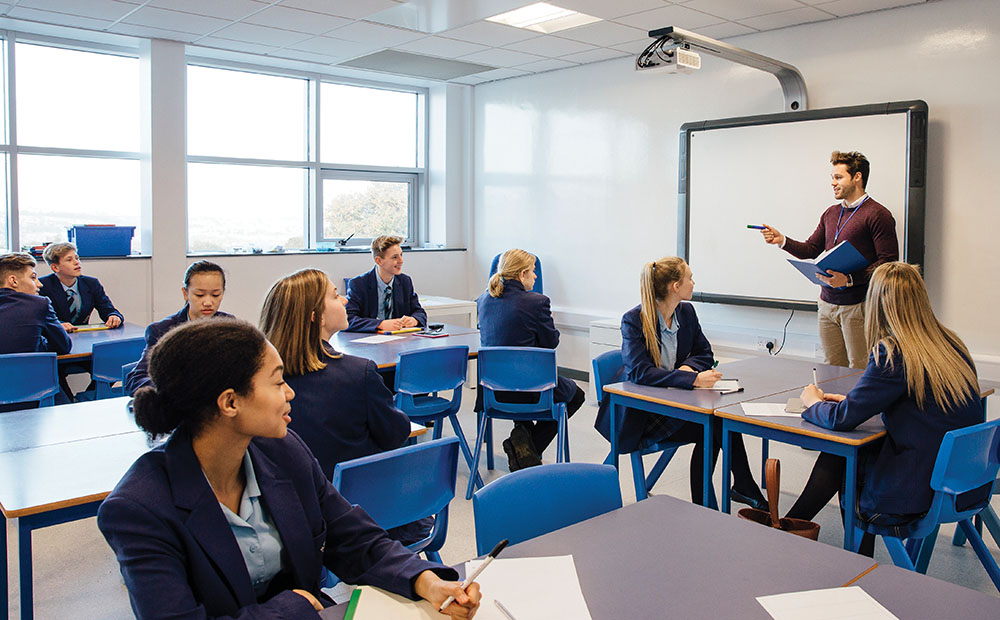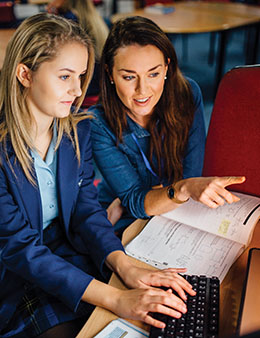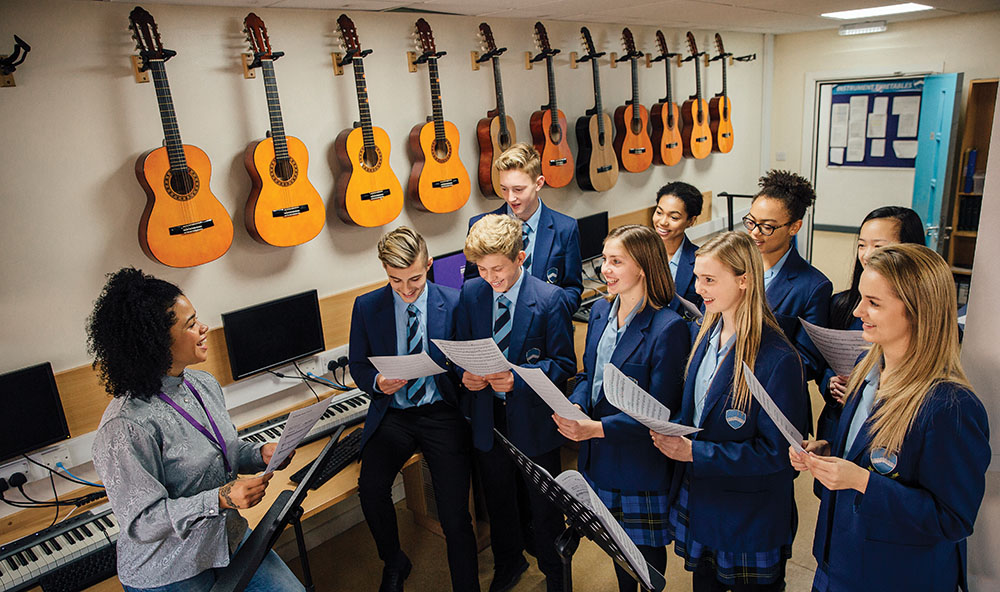With school open day season upon us, Charlotte Phillips takes a look at the questions to ask, the stats you need, and the areas worth seeing
Winter may still have us deep in its clutches, but schools are thinking well ahead – to the next academic year and beyond.
They want every seat in the classroom filled and that means wowing prospective parents with tales of success, both in and out of the exam room.
Their top (if not so secret) weapon? The open day. Cleverly designed by education experts at the top of their game, the aim is to ensure visiting families are wowed by a pretty-as-a-picture presentation of school life. They’ll have a bevy of perfect pupils to show you round (the kind you can’t help hoping your child will grow into), while the head teacher will be at their jolliest, blending gravitas with just the hint of a twinkle in their eye when they make their speeches.
It’s enough to make you want to sign up then and there (and some parents – overwhelmed by the 360° wonderfulness – do just that). And if you’re sure you’ve found your educational Mr, Ms or Mx Right – congratulations.
For most families, though, it’s more a case of steady as she goes. Yes, schools in our area are notably good at what they do, so you’re unlikely to be disappointed. But there’s more to their educational offering than just open days – like what they get up to during the rest of the school year.
How can you be certain that your child is going to be getting a top class educational experience on every day of term? What happens if it’s not plain sailing and there’s a problem? And how should parents be using the open day to find out?
To help them see past the razzmatazz, we’ve talked to schools to get the low-down on what really matters when it comes to getting the most from open days: what to ask, what to look for – and what to do with the information once you’ve got it.

How, when & why – key questions to ask
There’s no such thing as a ‘wrong’ question
Ask anything you need to – if it matters to you, it’s important, stresses Victoria Robeson, head of marketing and admissions at CIS. Every child and every school is different. Only a parent is going to know their child’s interests, talents and motivators – they are bound to have different concerns about their education. “If you’ve got this question, it’s obviously important to you to get the answer, so don’t be shy of asking it, even if it’s different to everything the others are asking.” And if you’re not satisfied with the answer, keep asking, says Andrea Joyce, vice principal & COO at Cambridge Leadership College. “Don’t be afraid to qualify those questions and interrogate that information.”
I can’t afford the school fees – can the school help?
Cast British reserve aside and don’t be bashful about asking for financial assistance if you’d like your child to attend an independent school but don’t have the funds. Many schools will have a pot of money (often donated by former pupils) that’s put aside specifically to help deserving families of bright children with the fees. Some schools even offer help – usually through bursaries – that’s worth more than 100{b486c5a37ab2d325d17e17d701cb2567b1ecd1814e8ceb33effa2a4f1f171d46} of the fees to cover all the other costs, like uniform and school trips. “It provides the opportunities for those who would not have had the chance of an independent education,” says Paul Wellstead, marketing director at Culford School. “It’s usually means-tested but can make a huge difference in making fees more affordable.”
Can you make the logistics work for Your family?
With more working parents juggling meetings and pickup times, it’s vital to know just how schools can help them reduce stress levels.
“A school might tick every box you’ve got on your list but if you cannot physically get your children there, it’s never going to work,” says Victoria Robeson. Ask if they have a breakfast club and how long they can stay on at school at the end of the day. “If you know you have a conference call at half past three two afternoons a week, you need to know you can finish your call and then collect your children.”
What’s the gender mix?
Year groups can vary dramatically when it comes to the split between boys and girls. One year, with a 50/50 mix, can be followed by another where boys, or girls, can dominate. “The mix of boys and girls in a class may determine how quickly or, moreover, how much your child will integrate into school life and make good friends,” says Paul Wellstead.
Just how hard do pupils have to work?
It may sound obvious but successful schools that boast of success in every sphere – matches won, musicals staged and exams aced – don’t do it by magic. There may be rehearsals and team practice before and after school and at every break time. So just what will your child be expected to commit to on top of all those lessons – will they be able to cope and still get enough sleep? “Ask about the length of the school day,” urges Victoria Robeson. “What percentage of pupils will take part in lunchtime clubs and how many extracurricular activities do you expect my child to take?”
What about trips?
Trips are far from being an educational frippery, stresses Andrea Joyce. Instead, they’re an essential. “They can tell you a lot about how much emphasis is placed on the holistic part of learning.” In a trip organised by her college to the Netherlands, students enjoyed work experience at media giant Viacom. “It was hugely valuable,” she says. Yes, it took a whole week out of the curriculum but it was worthwhile. “We owe it to our students to give them these richer experiences as well,” she says.
Who is your leader?
If you’d assumed that every pupil will know their principal’s name, you may be in for a surprise, says Andrea Joyce. “I’d always ask ‘who is your principal and have you ever spoken to them?’ Even in a larger Sixth Form if the student doesn’t know the name of their principal it does say a lot about the leadership of that college.”

Pay attention to…
The Mood
“When visiting a school, you should be on the look out for happy children who are engaged and enthusiastic about being there,” stresses Richard Settle, head teacher of Sancton Wood School. “You also want to see informed teachers who know their subjects and their pupils well and an overall feeling of joy and excitement for learning. Listen to the head teacher speak as they should impart the ethos and priorities of the school, speak to as many pupils and teachers as you can about their everyday experiences at the school and ask yourself is this the right place for my child? Ultimately that is the only question that matters, every child is different, and you need to find the school that fits with your child, their interests and personality.
“Exam and inspection results are important,” he adds, “as are facilities and extracurricular opportunities, but so too is the feeling you get when you walk into a school, if you instantly feel at home, this might just be the school for your family.”
The dining hall
A school that puts lots of care and thought into its menus will do the same in other areas, says Culford’s Paul Wellstead – and will show how seriously the school takes pupils’ health and well-being. “Providing a wide selection of food, showing where it is sourced and how nutritious the servings are will say much about the care and attention a school affords its students.”
The loos
The state of the loos can tell you a lot about what a school really thinks about its pupils and visitors. They don’t have to have state-of-the -art hand dryers – but they must be clean. “In a restaurant if you don’t like the loos you won’t eat there,” points out Victoria Robeson of CIS. “It’s all about that impression you create and in any school that is customer focused, it is an important area.”
The facts and figures that really matter
What’s the pupil to teacher ratio – and why is it important?

As a rule, the smaller the class size, the better. But you also need to know how many pupils there are to every full-time teacher. It will help you understand how well resourced a school is overall. Classes may be large but with lots of the day spent working in smaller groups. And think about what’s going to suit your child, says Victoria Robeson. “If you have a very shy child that needs lots of encouragement in the classroom then you probably want smaller ratios. It means the teacher is going to notice your child and give them the encouragement to speak up.” With an outgoing, gregarious child, however, it can be a different story – they might thrive in a bigger environment.
Never mind the league tables – show me the added value
League tables, which rank schools by their exam success, are a mixed blessing. Parents love them – they’re (fairly) easy to understand and make it easy to see how well their child is likely to do in exams. But they’re a very blunt instrument. “[A school may be] brilliant, high up in the league tables but because it’s highly selective, you’ve got to be fairly academic to be accepted,” says Victoria Robeson. “That means it’s always going to be higher in an exam results table than a non-selective, more rounded type of school.” So ask about the value the school adds to your child during their school career. If they arrive at school aged 11 on track to achieve C grades at GCSE (or their numerical equivalent), will the school’s approach help them do better than expected? When you’ve got the figures, make sure you’ve got an explanation of how they’ve been worked out.
Retention figures
Not the most exciting sounding words – but ones that really matter. Basically, how good is a school at ensuring pupils make it through the academic year? “Retention data can tell you quite a bit about the support that’s in place,” says Andrea Joyce from Cambridge Leadership College. “If a student is having difficulties on their course, they’re not just told to leave. Instead, any halfway decent school puts a lot of support in place before any kind of decision is made about changing courses or leaving courses.”
It also signals that schools are good at ensuring that students really understand the course before they sign up for it. Robust initial conversations are key, advises Andrea. “Schools should be asking pupils why they want to take courses, what they know about them already and what they think they’re about.” Get it right, and students are far more likely to – literally – last the course.
What Else?
Before you get too caught up in the numbers, say David Rose, director at Brookes Cambridge, remember that they don’t always provide the best picture of a school. “How can you measure the confidence, motivation and perseverance of pupils and the way that teachers respond to them? If you don’t have time to visit a school to at least get a feel for the atmosphere, then try to talk to other parents, look at the website and the social media pages, find the inspection reports and get answers to the simple questions.
“It’s also worth asking about the length of the school year, the school day, a lesson, and confirming what’s included in the school fees. Find out if you’ll have to pay for before and after school care; for activities, additional support, trips and visits etc so you don’t get any surprises. Also: ask where pupils go when they leave the school – college and university destinations, acceptances into other selective independent schools. Then ask yourself, does this school feel right for my child?”

